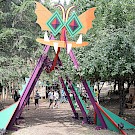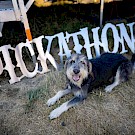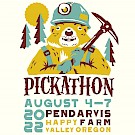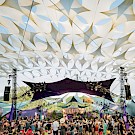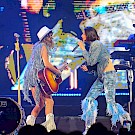 To festival, or not to festival... that is not even a question. Photo by Jason Quigley
To festival, or not to festival... that is not even a question. Photo by Jason Quigley
Perfection is in the eye of the beholder. And nowhere in life do our tastes vary so wildly or are our opinions held so strongly as when it comes to music. But one thing is certain: It’s human nature to congregate and nothing has typified the communal desire to share an experience with others more than the rapid rise of the music festival in America.
While having a name or two headlining your festival’s bill does matter, today’s most successful music festivals focus on experience—the creation of a complete package where you can immerse yourself and get lost in the moment surrounded by others doing the same.
Yet, ideas of perfection differ based on your age, interests, musical preferences and, frankly, how much you’re willing to spend or travel. And while we often think of perfection as an end state, it’s actually about progression: the process of improving something until it is flawless—or at least as flawless as possible.
So as the musicians we love seek artistic perfection in their sonic offerings, we concertgoers seek perfection in our festival experiences. And we at Vortex believe pieces of that perfection lie in the following festivals.
 Photo above by Drew Bandy from What The Festival—click to magnify this information
Photo above by Drew Bandy from What The Festival—click to magnify this information
Location, location, location: It’s important but setting the right scene for your perfect festival experience depends on what you’re in the mood for.
Whether on the farm, nestled into the woods or smack dab in the middle of the city, the urban versus natural environment will definitely inform your festival experience. It may also determine how far you will travel, where you’ll sleep, and ultimately how immersed you might become in the overall experience.
Pockets right around Portland have enabled a festival like Pickathon to earn the title “the festival for people who don’t normally like to go to festivals,” says principal partner Ned Failing. Known for its forested nooks and crannies and singular stages on 80 acres at Pendarvis Farm, a similar natural vibe can be found west of Portland as well at Horning’s Hideout, which hosts Northwest String Summit. “It is literally a hideout and oasis,” says fest promoter Skye McDonald, mentioning the natural amphitheater surrounded by old- and second-growth firs and spruces, rolling meadows, and even fishing ponds on the property—which all add up to tons of shade and plenty of camping and picnic options.
Yet, the city can offer an accessible and convenient—albeit more confined—space that’ll likely allow you to sleep in your own bed at night. Both Portland’s MusicfestNW and Waterfront Blues Festival take advantage of Tom McCall Waterfront Park.
“The location is crucial to our success,” says WBF artistic director Peter Dammann. The sloping, grassy bank along the Willamette allows for a Fourth of July fireworks display to take place in the middle of the river, and it also impacts the artists—many are impressed by the flotilla of fans on boats and a glowing Mt. Hood looming in the distance, Dammann explains. “It is a spectacular setting.”
The scenery may also enable you to change your pace: With one stage, Willamina’s Wildwood MusicFest (located on more than 50 rural acres at organizer Kim Hamblin’s Roshambo ArtFarm) was born of a community of “logging families, artists, hippies, and folks who have experienced the faster-paced urban life and have slowed things down by choice,” says co-founder Katie Kendall-Vinson. “The peaceful country setting helps set the tone: a relaxed weekend enjoying music, art, nature and one another.”
 Photo by Drew Bandy from What The Festival—click to magnify this information
Photo by Drew Bandy from What The Festival—click to magnify this information
City versus country aside, humans have a tendency to form tribes and the festivals you attend say something about you. While it’s easy to ravage a campsite and leave behind mounds of leaking garbage bags, mangled lawn furniture and stinking porta-potties (as witnessed at many large festivals), a festival’s vibe can often depend on how many people are in attendance.
 Slow Magic at What The Festival 2015: Photo by Drew Bandy—click to see a whole gallery of WTF photosBooking a music fest is a tricky business, and starting a new one is an even riskier proposition. Festivals are also in the business of building reputations and brand loyalty. People like to know what to expect from the experience—and for their money.
Slow Magic at What The Festival 2015: Photo by Drew Bandy—click to see a whole gallery of WTF photosBooking a music fest is a tricky business, and starting a new one is an even riskier proposition. Festivals are also in the business of building reputations and brand loyalty. People like to know what to expect from the experience—and for their money.
According to a recent Nielsen report on 2014 trends, 32 million Americans attended at least one festival last year, with a third (or 10.7 million people) attending more than one. Almost half of all festival-goers were millennials: 14.7 million individuals aged 18 to 34. Unsurprisingly, an Eventbrite study found that those talking most about festivals online were in that same age range. But analysis of those conversations found that: “People discussing festivals are talking significantly more about the experiential nature of these events and less about the specific artists and performances,” meaning “individuals consider festivals to be more about the overall experience and not just about going to a concert.”
While the overall lineup matters, it may be the experience that’s attracting audiences and ultimately contributing to a festival’s longevity.
 Photo by Drew Bandy from What The Festival—click to see a whole gallery of WTF photos
Photo by Drew Bandy from What The Festival—click to see a whole gallery of WTF photos
The experiential, extracurricular ecosystem is embodied nowhere better than at a youthful affair like What The Festival. Offering a full-immersion event that goes beyond the stages, WTF allows wanderers to drift throughout the 250-acre grounds of Wolf Run Ranch enjoying spectacular views of Mt. Hood and Mt. Adams while discovering the hookah lounge, spa, silent disco beneath a massive shimmering ball (pictured above left—see daytime photos by Drew Bandy here), bars, a marketplace with food and craft vendors, dance and yoga classes, and the alluring splash pool with daytime DJs (see more photos here). Most striking might be the myriad art installations, crowned by The Illuminated Forest (see nightime photos by Drew Bandy here) that offers an opportunity to get lost in a different interactive experience by day and night.
From backyard potluck to planned event, Wildwood continues to add amenities as the festival grows. There are plenty of activities for kids, a trolley that circles the festival grounds as well as stops by a swimming hole, and a special wine tasting with an acoustic performance at the hilltop Raven’s Roost Cabin. Plus, there’s enough made-on-site cider to go around from Hamblin and her husband’s cidery.
All of the property gives folks “a ridiculous amount of elbow room,” Kendall-Vinson says. Yet, her and Hamblin “are not interested in maxing out attendance but rather finding what is a comfortable number for the space and sticking with it. That cap will be dictated by geography.”
A physical space can only hold so many people, but some capacity caps are also conscious decisions.
 Photo by Jason Quigley
Photo by Jason Quigley
Ultimately, throwing the perfect festival is about creating community. And community is created by participation.
 The best-run festivals have abundant support from those who seek to take ownership: volunteers. For a mid-sized festival, Pickathon boasts an impressive number of volunteers (about 1,000 out of roughly 5,500 on-site each day including staff, musicians and vendors) and it’s likely this individual investment that makes the festival special.
The best-run festivals have abundant support from those who seek to take ownership: volunteers. For a mid-sized festival, Pickathon boasts an impressive number of volunteers (about 1,000 out of roughly 5,500 on-site each day including staff, musicians and vendors) and it’s likely this individual investment that makes the festival special.
Celebrating the Portland music scene, PDX Pop Now! is 100 percent volunteer run—that includes board members, coordinators and even the bands who play the fest. A core tenant is free access to live music for all ages, which also makes it a popular place for teens who are so frequently excluded from the bar scene.
Taking an ownership stake in a festival’s experience is important to Karl Nielsen—he’s been attending music festivals of all kinds for the past decade including 25 over the last two years. “This is my year of trying to be a little bit less of a consumer and more of a contributor,” he explains. Of course, he sees nothing wrong with buying a ticket and simply “enjoying the experience that’s been facilitated for you”—he’s been doing it for years. But recently, “I’ve really been drawn to contributing energy to help co-create the experience for everybody else because, at this point, I’ve been going to festivals for so long that it has really shaped who I am and what I value. Now, I’m ready to give back and help other people have similar experiences.”
He prefers work trades that “make the experience what it is,” Nielsen says. Pickathon, String Summit and Wildwood also emphasize that volunteers are the backbone of the event, each specifically mentioning that they’re the smiling faces who greet you, show you where to park and camp, answer questions and, most importantly, pour your beer! They’re often also the ones that prep the grounds in advance of the festival, keep it tidy during, and clean up after.
 Photo by Miri Stebivka from Pickathon
Photo by Miri Stebivka from Pickathon
It pretty much goes without saying that Pickathon is the “model for sustainability for all other festivals to follow,” Failing says. Solar power offsets energy used to run lights, stages and vendor booths, and there are no single-use items like paper plates or plastic cups and utensils. Instead, there are dishwashing and compost stations that enable the reduction of trash and waste. Plus, the countless volunteers (especially those on the recycling and compost team) as well as repeat attendees mean that the Pickathon populace has taken the festival’s philosophy to heart and respect it.
Maybe our attention to these details resonates with the community of festival-goers,” says farm owner Sherry Pendarvis. “They look at it and say, ‘Oh, this is a beautiful place. And maybe we don’t want to muck it up too badly.’”
 Photo by Jason Quigley
Photo by Jason Quigley
“A really good festival has to have intention behind it,” Nielsen says. And the intentions of the attendees matter too. Scenes can be about styles of music, partying hard, spiritual enlightenment, or just coming together as a community with shared values.
“The Oregon Food Bank actually owns and produces the Waterfront Blues Festival,” Dammann says. “It’s the only big festival in the world, that I know of, that’s produced by a social services agency.” It’s also, on some level, basically a free festival (Dammann reveals that only 60 percent of attendees pay), yet one that has raised about $10 million for the food bank over the years.
“A lot of acts respond to the civic cause and they understand that what they’re doing is more than entertaining people for the afternoon,” Dammann explains. Moved by the community effort in action, the first time Steve Miller came to play he was so impressed by the whole event that he simply wrote his check back to the food bank, Dammann recalls.
 Photo by Miri Stebivka from Pickathon
Photo by Miri Stebivka from Pickathon
“We pride ourselves on being a very family-friendly event and thus cater to those folks as much as possible,” String Summit’s McDonald says. Proof is in the numbers: Nearly 1,000 children under 10 years old attend each year with their families. This means NWSS has plenty of morning and daytime programming and entertainment for all ages, including a kids tent with arts and crafts, a kids parade led by giant puppets and costumes, and a family camping area that’s kept quiet and relaxed.
Pickathon provides a similarly large offering of family-friendly activities throughout the festival’s days. At some fests, campgrounds can be burdensome, lawless and debaucherous areas, but even performers have commented on Pickathon’s ability to create a very natural, safe environment: “It’s really well run, where it feels safe enough for little kids to run around but it doesn’t feel policed—it just feels like you’re camping with tons of other people,” says Blind Pilot’s Israel Nebeker.
And while community can sometimes be enough to draw certain people to a fest regardless of the music, we all know that the sonic experience is the primary reason why we gather (and pay for it).
 Photo by Jason Quigley—click to magnify this information
Photo by Jason Quigley—click to magnify this information
Even amongst tight-knit communities, money is often a touchy subject. So, it’s no surprise that most commercial festivals will not disclose their budgets: “Sorry, this information is confidential.” It’s also no secret that throwing a successful festival isn’t easy or cheap.
String Summit’s McDonald sums up how most mid-sized festivals feel: “It is a giant jigsaw puzzle. We strive to keep our event as affordable as possible while keeping up with the ever-growing inflation of the industry,” basically “making it a very low-margin event.”
“The costs add up quickly,” echos What The Festval’s Keely Montgomery, one of the fest’s producers and its operations director. “In this industry, you are a success if you are simply able to break even!”
“This has never been about making money,” Wildwood’s Kendall-Vinson says. It’s always been much more about supporting community and local organizations, from public school art and music programs to farm-related orgs and the food bank.
Whether you’re throwing a free affair, spending anywhere from $40,000 like PDX Pop Now! or more than $1 million for the Waterfront Blues Festival, or running a for-profit fest with presumably much larger budgets, cost is a very real concern for festival-goers.
 Photo by Jason Quigley
Photo by Jason Quigley
Certain festivals—most often those that involve getting away for the weekend—engender a more immersive experience. While regular Pickathon attendees talk of bumping into the same folks year after year and continuing their relationships on the festival grounds, as we congregate, “there’s the initial unity of just being there for the same reason,” Nielsen says. “The music, the journey into self, and the self-discovery that you can experience in these groups of people really creates some very deep bonds.”
At festivals, “we come together as a conscious culture and community to enjoy each other and celebrate in a way that we can’t really do when we’re in our 9-to-5 routines,” Nielsen explains. These encounters outside of our normal day-to-day sphere allow for enhanced expression: Festivals are “a celebration—a celebration of life, a celebration of creativity, a celebration of self-expression. It’s important to have these gatherings so you can feel in your heart and soul the power of community,” Nielsen says.
 Photo by Jason QuigleyNielsen also runs his own festival fashion business, the sparkle-fied Fractal Funhouse, born out of his desire to add his own creative expression to the mix of faux fur, steampunk goggles and neon spandex found on many a festival ground. Positive feedback from the community (and a demand to buy his creations) led to the realization that “making clothing could transition from a festival habit to a lifestyle,” he says.
Photo by Jason QuigleyNielsen also runs his own festival fashion business, the sparkle-fied Fractal Funhouse, born out of his desire to add his own creative expression to the mix of faux fur, steampunk goggles and neon spandex found on many a festival ground. Positive feedback from the community (and a demand to buy his creations) led to the realization that “making clothing could transition from a festival habit to a lifestyle,” he says.
From the cities we live in to the tribes we form at festivals, humans have an innate need to gather and music brings us together as we seek a shared experience. A new setting away from your normal existence can stimulate and intensify your singular experience.
Festivals offer exposure “to some people who are living very different lifestyles than you are. In that exposure, I feel like we expand in our perception and awareness of what’s possible,” Nielsen explains. “Sometimes people just don’t know that something else is possible.” When Nielsen discovered festivals, he found home: “These are my people, this is my place,” he realized. “And I can be weird and dance weird and be goofy and know that I’ll be accepted because that’s kind of what we go to festivals to do: Get weird.”





